Mammoth Megafauna Mammal Massacre
Posted by: Loren Coleman on March 9th, 2012
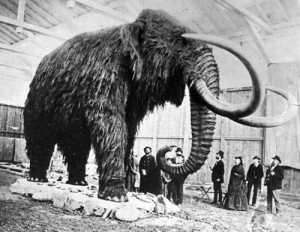
Ivan T. Sanderson may have been right, after all. The news this week is that mammoths and other megafauna could have been wiped out due to the after effects of a giant asteroid. It happened during a period that is nowadays called the “Young Dryas,” but more about that in a mastodon minute.
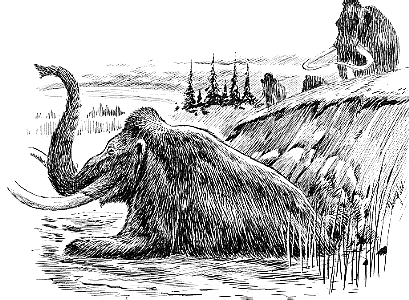
The debate about what killed the mammalian megafauna of the Pleistocene (or Ice Ages, if you will) continues. I’ve looked at various sides of this issue for years here. As a friend of Ivan T. Sanderson, I enjoy thinking open-mindedly and skeptically about his buttercups-in-the-mouths-of-the-mammoths theory of freezing cloudbursts. New developments need to be reviewed to keep up-to-date.
This week, due to a study in Proceedings of the National Academy of Sciences, a 16-member international team of scientists found evidence that 12,900 years ago something large, very large, indeed, wiped out the megafauna.
Summarizing what was discovered, The Register wrote:
The researchers found an ancient layer of thin, dark sediment buried at the bottom of Lake Cuitzeo in central Mexico that contains nano diamonds, impact spherules and other exotic materials that are only found after a cosmic impact.
The study shows that an asteroid that was probably bigger than several hundred metres in diameter and blasted through the atmosphere at a shallow angle, burning up biomass, melting surface rocks and causing major environmental disruption.
“These results are consistent with earlier reported discoveries throughout North America of abrupt ecosystem change, megafaunal extinction, and human cultural change and population reduction,” James Kennett, professor of earth science at UC Santa Barbara, said in a tinned statement.
The sediment layer under Lake Cuitzeo is the same age as layers previously found in numerous locations in North America, Greenland and Western Europe, extending the asteroid’s range into Mexico and the tropics for the first time.
This species-destroying asteroid is one of only two that boffins have found
evidence for in sediment layers, the other being the dino-destroying rock that hurtled into the planet 65 million years ago. The second impact took place 12,900 years ago at the onset of an unusual cold climatic period called the Younger Dryas.“The timing of the impact event coincided with the most extraordinary biotic and environmental changes over Mexico and Central America during the last approximately 20,000 years, as recorded by others in several regional lake deposits,” said Kennett.
“These changes were large, abrupt, and unprecedented, and had been recorded and identified by earlier investigators as a ‘time of crisis.’ ”
The mammoth-murdering asteroid is also associated with the extinction of other North American animals including mastodons, sabre-tooth cats and dire wolves.
You may recall that in the 1960 Saturday Evening Post article, “Riddle of the Frozen Giants,” zoologist and founding cryptozoologist Ivan T. Sanderson wrote of his catastrophic astronomical theory to explain the frozen mammoths and frozen wooly rhinos. Sanderson was laughed at for his thoughts. But was he right, after all?
Sanderson’s claims were frequently debunked because, among other items, mammoths were supposedly said to have rotten before they froze. But were some of his basics grounded, instead, in good data and logic?
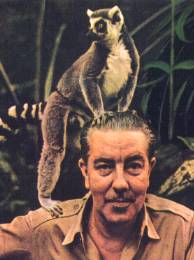
Ivan T. Sanderson (above), Charles Hapgood, and a bit more radically, perhaps, Immanuel Velikovsky appeared to have been partially vindicated, first by a small research announcement, in 2007.
Over twenty scientists working as a team released a statement at a meeting of the American Geophysical Union in San Francisco that year noting they had found indications of space impacts in prehistoric ivory.

According to the BBC News: “Startling evidence has been found which shows mammoth and other great beasts from the last ice age were blasted with material that came from space. Eight tusks dating to some 35,000 years ago all show signs of having being peppered with meteorite fragments. The ancient remains come from Alaska, but researchers also have a Siberian bison skull with the same pockmarks.”
Wait a minute? Mammoths killed by debris from outer space? These remarkable new findings are confirming a major component of Sanderson’s theory: the mammoths were hit by debris from outer space!
“We think that there was probably an impact which exploded in the air that sent these particles flying into the animals,” said Richard Firestone from the Lawrence Berkeley National Laboratory. “In the case of the bison, we know that it survived the impact because there’s new bone growth around these marks.”
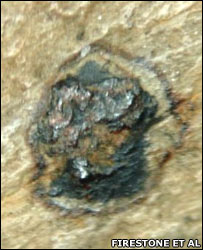
The mammoth and bison remains all display small (about 2-3mm in size) perforations. Raised, burnt surface rings trace the point of entry of high-velocity projectiles; and the punctures are on only one side, consistent with a blast coming from a single direction.
Viewed under an electron microscope, the embedded fragments appear to have exploded inside the tusk and bone, say the researchers. Shards have cut little channels.
The sunken pieces are also magnetic, and tests show them to have a high iron-nickel content, but to be depleted in titanium.
The ratios of different types of atoms in the fragments meant it was most unlikely they had originated on Earth, the team told the AGU meeting.
The discovery follows on from the group’s previous research which claimed a more recent space collision – some 13,000 years ago. The researchers reported the discovery of sediment at more than 20 sites across North America that contained exotic materials: tiny spheres of glass and carbon, ultra-small specks of diamond and amounts of the rare element iridium that were too high to be terrestrial. The scientists also found a black layer which, they argued, was the charcoal deposited by wildfires that swept the continent after the space object smashed into the Earth’s atmosphere. ~ Jonathan Amos, “Great beasts peppered from space,”, BBC News, December 12, 2007.

“We had found evidence of particle impacts in chert, or flint, at a Clovis Indian site in Michigan,” Dr Firestone said.
“So, we got the idea that if these impacts were in the chert, then they might likely also have occurred in large surfaces such as tusks; and we decided it was worth a shot to go look for them.”
Allen West began the hunt at a mammoth tusk sale in his home state of Arizona.
He immediately found one tusk with the tell-tale pockmarks and asked the trading company if he could look through its entire collection. He sorted literally thousands of items.“There are many things that can cause spots, such as algae, and there were a few of those; but I was only interested in the ones that were magnetic,” he recalled. “It was just a tiny magnet on a string, but very strong. It would swing over and stick firmly to these little dots.”
The search turned up a further seven ivory specimens of interest, together with the bison skull.But having gone out and tested the hypothesis of tusk impacts, and having apparently uncovered such items – the team was then astonished to find the animal remains were about 20,000 years older than had been anticipated. ~ Jonathan Amos, “Great beasts peppered from space,”, BBC News, December 12, 2007.
This did result in further research and more looks at old tusks. The researchers think there must still be peppered tusks out there that can be dated to 13,000 years ago, and the hope is that the American Geophysical Union presentation will prompt museums and collectors to look through their collections of Pleistocene material, in future years.
Here at Cryptomundo, I did mention in “Space Strike Didn’t Kill Mammoths,” in 2010, that there are usually two sides to each new hypothesis. Debunkers will always resist new theories, and yet the evidence for this period now called Young Dryas is mounting. Debate on the existence of a Younger Dryas comet impact, 12,900 years ago, and whether it is linked to mass extinctions of large mammals and early humans in North America is ongoing. The Younger Dryas was a 1,300-year-long cold snap that affected climate in much of the Northern Hemisphere. In 2007, the team mentioned above, led by Richard Firestone of Lawrence Berkeley National Laboratory, in the U.S., argued that it was caused by the impact of a comet. In 2009, further evidence of the impacts from space were found. This week, the news details a giant asteroid theory.
Whatever it was, it wiped out such Pleistocene megafauna as the saber-toothed cat, the mastodon and the mammoth, along with the Clovis people, one of the earliest American cultures.
Putting this in context, Sanderson’s and geologist Charles Hapgood’s work that was quickly dismissed in the early 1960s, is beginning to more headway, as are recent other findings. Archaeologist Frank Hibben, likewise, found results he mentioned in his 1961 book, The Lost Americans, that put his work in the same framework.
With this new 2012 paper on the evidence for the giant asteroid, let us look, once again, at Sanderson brief paper. Are the observations that Sanderson and Hapgood shared back in 1960 making more and more sense, as the years sweep by and new evidence is uncovered?
In 1960, the Scottish-born American zoologist Ivan T. Sanderson wrote in his Saturday Evening Post article “Riddle of the Frozen Giants” about the Berezovka mammoth and his theory of its demise:
It now transpires, from several studies, that mammoths, though covered in a thick underwool and a long overcoat – and in some cases having quite a layer of fat – were not specially designed for arctic conditions; a little further consideration will make it plain that they did not live in such conditions. That they did not live perpetually or even all year round on the arctic tundra is really very obvious. First, the average Indian elephant, which is a close relative of the mammoth and just about the same size, has to have several hundred pounds of food daily just to survive. For more than six months of the year, there is nothing for any such creature to eat on the tundra, and yet there were tens of thousands of mammoths.
“Further, not one trace of pine needles or of the leaves of any other trees were in the stomach of the Berezovka mammoth; little flowering buttercups, tender sedges and grasses were found exclusively. Buttercups will not even grow at forty degrees (4.4°C), and they cannot flower in the absence of sunlight. A detailed analysis of the contents of the Berezovka mammoth’s stomach brought to light a long list of plants, some of which still grow in the arctic, but are actually much more typical of Southern Siberia today. Therefore, the mammoths either made annual migrations north for the short summer, or the part of the earth where their corpses are found today was somewhere else in warmer latitudes at the time of their death, or both.
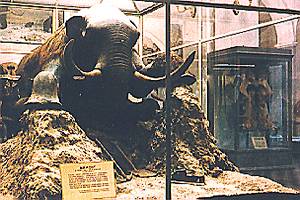
Here is a really shocking – to our previous way of thinking – picture. Vast herds of enormous, well-fed beasts not especially designed for extreme cold, placidly feeding in sunny pastures, delicately plucking flowering buttercups at a temperature in which we would probably not even have needed a coat. Suddenly they were all killed without any visible sign of violence and before they could so much as swallow a last mouthful of food, and then were quick-frozen so rapidly that every cell of their bodies is perfectly preserved, despite their great bulk and their high temperature. What, we may well ask, could possibly do this?
“Now, volcanoes, when in eruption, not only spew out lava and hurl out rocks but also eject masses of dust particles, steam and other gases. Some of the dust may be shot into the upper atmosphere and then drift all around the earth. … A sudden mass of extrusion of dust and gases would cause the formation of monstrous amounts of rain and snow, and it might even be so heavy as to cut out sunlight altogether for days, weeks, months, or even years if the crustal movements continued. Wind beyond anything known today would be whipped up, and cold fronts of vast lengths would build up with violent extremes of temperature on either side. Here would be forty days and nights of snow in one place, continent-wide floods in another, and roaring hurricanes, seaquakes and earthquakes bringing landslides and tidal waves in others, and many other disturbances. But perhaps more important may have been the gases which would probably have been shot up highest of all. What would have happened to them?
“And there is where we get back to quick-freezing mammoths, for the frozen-food experts have pointed out that to do this, starting with a healthy live specimen, you would have to drop the temperature of the air surrounding it down to a point of well below minus-150 degrees Fahrenheit (-101.1°C). There are two ways of freezing rapidly – one is by the blast method, the other by the mist process; these terms explain themselves. Moreover, the colder air or any gases become, the heavier it gets. If the volcanic gases went up far enough they would be violently chilled by the ‘cold of space,’ as it is called, and then as they spiraled toward the poles, as all the atmosphere in time does, they would begin to descend.
“When they came upon a warm layer of air, they would weigh heavily upon it and pull all the heat out of it and then would eventually fall through it, probably with increasing momentum and perhaps in great blobs, pouring down through the weakest spots. And if they did this, the blob would displace the air already there, outward in all directions and with the utmost violence. Such descending gases might well be cold enough to kill and then instantly freeze a mammoth.
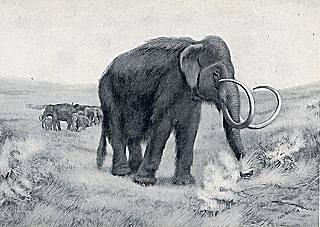
Consider now our poor mammoth placidly munching away in his meadow, perhaps even under a warm sun. The sky need not been clouded over, and here need not even be a dust of haze where he is living, which would appear to have been then about where Central Asia is today. All of a sudden, in a matter of minutes, the air begins to move in that peculiar way one may experience today at the end of the arctic summer when the first cold front descends and the temperature may drop sixty degrees (15.5°C) in an hour.
“All the mammoths feels is a sudden violent tingling all over his skin and a searing pain in his lungs; the air seems suddenly to have turned to fire. He takes a few breaths and expires, his lungs, throat, eyeballs, ears and outer skin already crystallized. If he is near the center of the blob, the terrible mist envelops him, and in a few hours he is a standing monument of what is virtually rock. Nor need there be any violence until the snow comes softly to pile up on him and bury him. And here we leave him for a moment and turn to his distant cousin chewing away in Alaska, just outside the area where the blob descends. What happens to him?
“The sky here probably does cloud over, and it may even start to snow, something he has not before encountered in September, when he is in the north on his summer migration. He starts to pad off for cover. But then comes a wind that rapidly grows and grows in fury and explodes into something unimaginable. He is lifted off his feet and, along with bison, lion, beaver from ponds, and fish from rivers, is hurled against trees and rocks, torn literally to bits and then bowled along to be finally flung into a seething caldron of water, mud, shattered trees, boulders, mangled grass and shrubbery and bits of his fellows and of other animals. Then comes the cold that freezes the whole lot, and finally, when the holocaust is over, the snow covers it all.
“This is exactly the state of affairs that we find in Alaska, where the mammoths and other animals, with one or two significant exceptions, were all literally torn to pieces while still fresh. Young and old alike were cast about, mangled and then frozen. There are also, however, other areas where the animals are mangled, but had time to decompose before they froze; and still others where they decomposed down to the bones and were then either frozen or not. Beyond these again, there are similar vast masses of animals, including whole families or herds, all piled together into gullies and riverbeds and other holes, but where only bones remain.

Here may be the answer to our riddle of why we find mammoths with buttercups in their teeth in one place, shredded but still-edible mammoths in another, rotting mammoths in a third, and mammoth boneyards somewhere else. The animals were frozen whole where the blobs of cold air descended before the wind began, shredded and frozen where the winds came before the cold had spread out, and reduced to bones where the animals had time to decompose before the cold reached them or the moving crust (of the earth) carried them north.
“The remains, if still sticking out of the ground where the middle of the blob occurred, would have been safely sealed in when the snow came, as the Berezovka mammoth probably was. This would seem to be additional proof, for a true ice-cap never formed in Siberia, because the crust was still shifting. There is evidence that one once started to grow there, but that it soon died away, and as it did so, vast floods of melt water brought great quantities of silt down from the south – which is the direction the rivers flow in Siberia – and deposited it upon the compacted snow. This froze in the fall, but melted in the spring, and since a dark material absorbs more heat, it gradually, year by year, dissolved the snow below and descended upon and eventually enveloped the quick-frozen mammoth by the slow substitution of chilled silt for compacted snow. Ivan T. Sanderson, 1960, Saturday Evening Post, “Riddle of the Frozen Giants.”
Frankly and personally, once the dating is brought into some kind of controlled regularity, I think we will find that a major event did occur at the 12,900 years-before-present date, worldwide. The extinction of Clovis people in some areas, megafauna rather broadly, and other species will be more correctly documented. Additionally, we can then also map where the survivors were and perhaps begin to find that evidence too.
About Loren Coleman
Loren Coleman is one of the world’s leading cryptozoologists, some say “the” leading living cryptozoologist. Certainly, he is acknowledged as the current living American researcher and writer who has most popularized cryptozoology in the late 20th and early 21st centuries.
Starting his fieldwork and investigations in 1960, after traveling and trekking extensively in pursuit of cryptozoological mysteries, Coleman began writing to share his experiences in 1969. An honorary member of Ivan T. Sanderson’s Society for the Investigation of the Unexplained in the 1970s, Coleman has been bestowed with similar honorary memberships of the North Idaho College Cryptozoology Club in 1983, and in subsequent years, that of the British Columbia Scientific Cryptozoology Club, CryptoSafari International, and other international organizations. He was also a Life Member and Benefactor of the International Society of Cryptozoology (now-defunct).
Loren Coleman’s daily blog, as a member of the Cryptomundo Team, served as an ongoing avenue of communication for the ever-growing body of cryptozoo news from 2005 through 2013. He returned as an infrequent contributor beginning Halloween week of 2015.
Coleman is the founder in 2003, and current director of the International Cryptozoology Museum in Portland, Maine.










I was fortunate and got to dig for a week on the Snowmass Village, CO dig site, which was primarily mastodons. The time frame of the dig site lasted just under 100,000 years. There was no single event that caused the massive deaths we dug up, at least there was no evidence for any. We did have one mystery – no large predators at all. For more information, check out the Denver Museum of Nature & Science’s website. Also, National Geographic filmed there and turned it into a NOVA tv show which isn’t too bad.
Thanks,
Aaron
Imagine the effects a planet the size of Neptune or Uranus would have if it passed between the Earth and Mars, and came close enough to both planets to interact with them to the point that Mars was almost totally transformed, and life on Earth was nearly wiped out. Does not that explain what happened to both planets, where an asteroid stiking Earth only explains what happened on Earth? Wouldn’t it be too much of a coincidence that an asteroid strike Mars at the same time, with the same effects? A planet that size passing close to Earth, could explain the multitude of changes that happened at the same time, where it’s difficult to explain them all with one asteroid. It appears the whole skin of the Earth shifted, like the skin of an orange,there were tsunamis thousands of feet high, earthquakes, volcanoes, and the one thing conventional science does not allow for, cosmic scale electrical events, huge lightning bolts capable of excavating huge amounts of earth, carrying them up to space, and then letting them drop back to Earth in materials of all sizes, from tiny, magnetized pieces of metal, magnetized by the electric bolt that excavated them, to boulder sized rocks that could carve out craters, like the Carolina Bays. Since it was a world wide event, it was subject to many variables, so it’s effects were not uniform, and survival was a very random event, unless one were warned in advance, as the circa 250 Flood stories from around the world, attest. Much of the evidence for this catastrophe, has been misinterpreted as ice ages, although the end result, was an ice age in the Arctic, and Antarctic, and much of the latitudes adjacent to them. What we call global warming today, could well be the Earth continuing to return to it’s normal state, from before the catastrophe.
Aaron,
I quite enjoyed the NOVA special on the Snowmass site. What was most interesting were the stones found around the masterdon remains. The preliminary thoughts were that they were ‘weight’ stones put there by humans to keep the kill fresh under the cold water. However this BLOWS away current theories on how early humans existed in North America. Has there been any further development on this theory?
Well, the evidence might seem to point to a pretty extraordinary event.
And those who have examined the evidence have long disputed the idea that humans did it; there simply never seemed to be enough of them.
Seems to point to the necessity for an open mind, methinks.
DJWCAW – to my knowledge, no further evidence has been dug up. Our leading paleo curator isn’t convinced and thinks Occam’s Razor is a better approach to why the scratches/grooves are there, rather than placing humans here tens of thousands of years before there is any more evidence. It is odd though, for sure. He presented recently, showing the grooves are too parallel for man-made cuts, compared to well established prehistoric butchering. It’s still early in the game though, so who knows what will come along to support the oddly placed boulders.
“I think we will find that a major event did occur at the 12,900 years-before-present date, worldwide.”
It is fascinating how that figures in with other discoveries such as Robert Ballard’s work regarding how water levels rose rapidly worldwide in an event that may be remembered as “the great Flood”. He gives a date around 9000 years ago. I can read this as a correlation to a rapid freeze that might have ended a few thousand years later as a rapid warming.
Aaron opened an entire can of worms with his remark stating his thought that the scratches being human were “tens of thousands of years before there is any more evidence” of humans around at the time.
Of course, this flies directly in the face of a growing body of findings showing that prehistoric human finds have been discovered below the Clovis level, some dating to 50,000 years before present.
See, here and here, for two easy examples.
haha
Well, I’m not an anthropologist, that’s for sure. I’m basing my comments on accepted anthro info. We have a curator in the museum who thinks he has evidence pushing early man in North America back over 10K years before accepted paradigms. The mammoth catch we recently dug up is almost twice as old as what even he is stating for early man in North America, but who knows.
Praise the heretics, for they have the temerity to ask the questions that change our view of things.
Chale! God sure seems to have a deep grudge with my country, what with this continuous attack of big-ass space rocks –Mexico: Magnificent Meteor Magnet :-/
PS: Here’s another example of evidence suggesting human habitation in the American continent older than 40,000 years old: The Valsequillo basin footprints, found in central Mexico.
Photo here.
Indeed. “Accepted anthro info” is highly questioned here.
“Accepted anthro info” formerly had no room for Kennewick Man either, and that had nothing to do with its BP age.
“Accepted anthro info” did not stand in the way of Louis B. Leakey’s discussions of early, pre-Clovis hand tools he examined in the USA. Or those tools found five feet below the Clovis level by Michael Waters (Texas A&M University), Steven Forman (University of Illinois), and Tom Dillehay (Vanderbilt University) ~ as reported in Science in 2011.
Open-mindedly, we must consider the Denver Museum finds as having the potential to be more evidence of early pre-Clovis humans, or some mighty violent earth movements!
We must not stop looking, however, because of “accepted anthro info,” of course, or we’d given up on Yeti and Bigfoot, long ago.
Loren: for sure.
Australia’s aboriginal population isn’t native; they traveled there. (How? Who knows.)
Neanderthals are the direct ancestors of modern man; they in turn descended from Homo erectus. (Um, maybe not so much.)
Man is the only animal who uses tools. (New ones every year, pretty much, since the early ’60s.)
Man killed the Pleistocene megafauna. (We’re talking about maybe not totally.)
Much “accepted info” is accepted because of a theoretical stab backed by, well, not much. Best to keep an open mind until more info is in.
To paraphrase mystery_man:
Science is a set of provisional truths, supported by evidence.
Key word, “provisional.”
The standard answer has long been that humans caused the megafaunal extinction around 13,000 years ago, but there were problems with this hypothesis, such as the fact that the extinction did not affect Africa, where humans had existed the longest. The evidence seems to be mounting for some kind of sudden, major event at that time.
Interesting reactions from some. At work I’m laughed at for being too open minded and here I’m attacked because I’m not open minded enough. hahaha
The scientific method demands repeat-ability. Statistical analysis likes large sample sizes. A sample of one might be an exception and not the rule.
I’m not denouncing anything. I’m only saying extraordinary claims need solid evidence to back it. I hesitate tossing out accepted facts for the latest hypothesis in a field of study that I’m not an expert in. If the evidence isn’t questionable then there wouldn’t be an argument about it.
DWA – I think a global network of anthropologists would be insulted by your “not much” statement. Granted, some scientists cling to past theories even in the face of new evidence. I’m not one (although Pluto is still a planet as far as I’m concerned, but that is a different discussion).
not for anything but does anyone realize what kind of temp drop you need to flash freeze a 6+ton living animal,
that could brave -30? F or C, take your pick.
are there no smaller animals in that condition?
mass = heat in warm blooded animals.
maybe a wave of liquid nitrogen rolled across the earth?
couldn’t there be a “cloud” of that, roaming around the solar system?
unless the atmosphere disappeared over the areas and exposed them to space, somehow.
i was hasty and i guess i missed a couple things in the sanderson article.
i was sort of close though, lol.
he mentions a volcano might have done the freezing? it sounds like a huge one to cover that much area. super volcano? but i never heard of one going off this recently.
wouldn’t 12,900yo put that around the time of atlantis or santorini? give or take a few years.